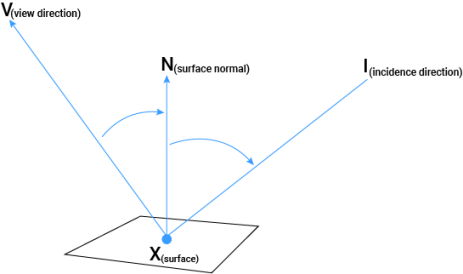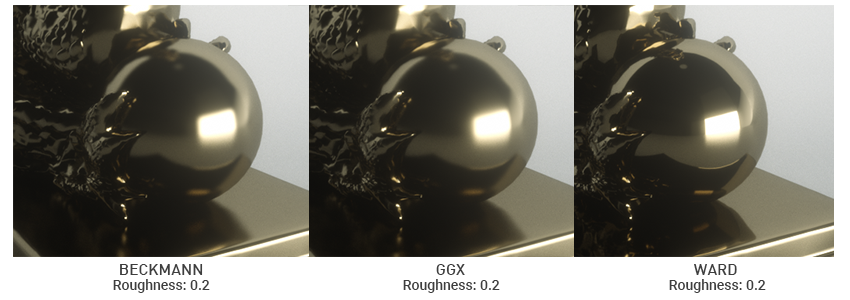
The BDRF model stands for Bidirectional Reflectance Distribution Function. This is a mathematical function of four real-world attributes that define how light is reflected at an opaque surface. BRDF is defined as the ratio of the reflected light (radiance energy) to the incoming light (irradiance energy) at the point "x" on the surface (figure 1).

Figure 1: Illustrating the Bidirectional Reflectance Distribution Function.
BRDF is one of the most useful models of reflection and was first described in the field of Radiometry. It deals with the directional distribution reflection of light from any surface. It does not deal with the part of the light that travels into the surface, it only deals with the reflected part. In fact, BRDF is a simplified version of the "Bidirectional ScatteringDefines how fast light gets scattered when traveling through the medium. Surface Reflection Distribution Function (BSSRDF)". In BSSRDF, it is also taken into account which point the light enter into the surface and where it left off from the surface. In BRDF the assumption is that the surface is homogeneous. Thus, the BSSRDF is reduced to BRDF.
Until the V3.08 version, Octane was using its original BRDF. There was conservation of energy in this model, but it was not fully functioning. In other words, the amount of reflected light was the same as the incoming light (in other words, always 100%).
Microfacets
With the new BRDF models, Octane tries to mimic the roughness while redefining the surface at the micro geometry level according to the Microfacet functions. These functions are the commonly used Beckmann, GGX and Ward BRDF functions. Unlike the original Octane BRDF, these three models allow for the creation of features such as Fresnel Effect and Anisotropic Roughness not previously available in Octane.
The biggest difference between these three Microfacet models is the SpecularAmount of specular reflection, or the mirror-like reflection of light photons at the same angle. Used for transparent materials such as glass and water. Lobe. These specular lobes are defined by the microfacet NDF (Normal Distribution Function). NDF describes the distribution of microfacets for the surface and unique to each BRDF model. Also this function is most responsible for the size and shape of the specular highlight (figure 2).

Figure 2: A comparison of microfacet models.
Anistropy
One of the new material properties of octane is Anisotropy. This feature allows for the design of complex metallic surfaces. Anisotropy is the reflection value changes by turning the surface around its normal. Examples of anisotropic surfaces include polished metal, human hair, fur and wood. In Octane, the anisotropy feature is available with the three new BRDF models. The results will be different for each of the three BRDF models because of their Microfacet functions.

Figure 3: Anisotropy control with the new BRDF modes.
DiffuseAmount of diffusion, or the reflection of light photons at different angles from an uneven or granular surface. Used for dull, non-reflecting materials or mesh emitters. MaterialThe representation of the surface or volume properties of an object.
Diffuse materials are simple materials compared to the other types. In this material, when the photons hit the surface, they are reflected in many different directions irrespective of the angle of incidence of light. If the surface is a smooth surface, the distribution of the photons is hemispherical, but there is no perfect smooth surface in nature. In reality all surfaces are more or less rough. It is therefore more reasonable to describe the diffuse reflection over rough surfaces. So, when photons hit a rough surface, they are scattered randomly instead of in a hemispherical scatter (figure 4).

Figure 4: Scattering of photons across a diffuse surface.